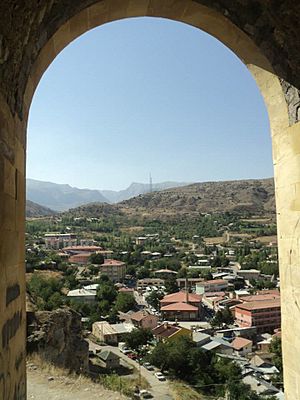Khosrovidukht facts for kids
Khosrovidukht (Armenian: Խոսրովիդուխտ, lit. daughter of Khosrov; fl. early 8th century) was an Armenian hymn writer and poet who lived in the early 700s. She is one of the first known women in Armenian literature and music. She was also one of the earliest women to compose music.
Khosrovidukht was the daughter of King Khosrov Goghtnatsi. Her father was killed, and she was put in prison in a fortress called Ani-Kamakh. This place is now known as Kemah in Turkey. She stayed there for twenty years. Her brother was also imprisoned and later killed. Khosrovidukht's only surviving work is a hymn called "Zarmanali e Ints" ("More astonishing to me"). She wrote it for her brother.
Her Life Story
Very little is known about Khosrovidukht, whose name is sometimes spelled 'Xosroviduxt'. She was active in the 8th century and was part of the royal family. Her father was King Khosrov Goghtnatsi. He ruled a region called Goghtn.
Her real first name is not known. The 'dukht' or 'duxt' in her name means 'daughter of'. So, Khosrovidukht means 'daughter of Khosrov'. She was also known by names like Khosrovidukht of Goghtn.
In the year 708, King Khosrov was killed during a conflict. Khosrovidukht's brother, Vahan Goghtnatsi, was taken by Muslim Arabs to Syria. Khosrovidukht was taken to the fortress of Ani-Kamakh. This fortress is now called Kemah. She stayed there alone for twenty years.
Her brother Vahan later became a Muslim. He then gained his freedom and returned to Armenia. After returning, Vahan became a Christian again. The same Muslims who had taken him away saw this as a crime. They had him killed. He died in either 731 or 737. Some sources suggest Khosrovidukht also died in 737.
Her Music and Poetry
Scholars did not know about Khosrovidukht's work until the 1800s. After her work was found, she was recognized as the second woman composer and poet from Armenia. The first was Sahakdukht, who lived a little earlier. Today, you can find a modern recording of her music. It is performed by the Sharakan Early Music Ensemble.
The only work that is believed to be by Khosrovidukht is "Zarmanali e Ints" (which means "Wondrous it is to me"). It is a type of hymn called a šarakan. Historian Agop Jack Hacikyan said her work showed "a great deal of literary skill."
Like Sahakdukht's work, Khosrovidukht's piece was not part of the official collection of šarakans. However, the Armenian Church later approved "Zarmanali e Ints" for use in church services. Later writings say that she dedicated this work to her brother after he died. Some scholars, like Ghevont Alishan, believe that Sahakdukht wrote this work instead.
Here is the original text of "Zarmanali e Ints":
| "Zarmanali e Ints" ("Զարմանալի է ինձ")
Զարմանալի է ինձ, |
See also
 In Spanish: Khosrovidukht para niños
In Spanish: Khosrovidukht para niños


